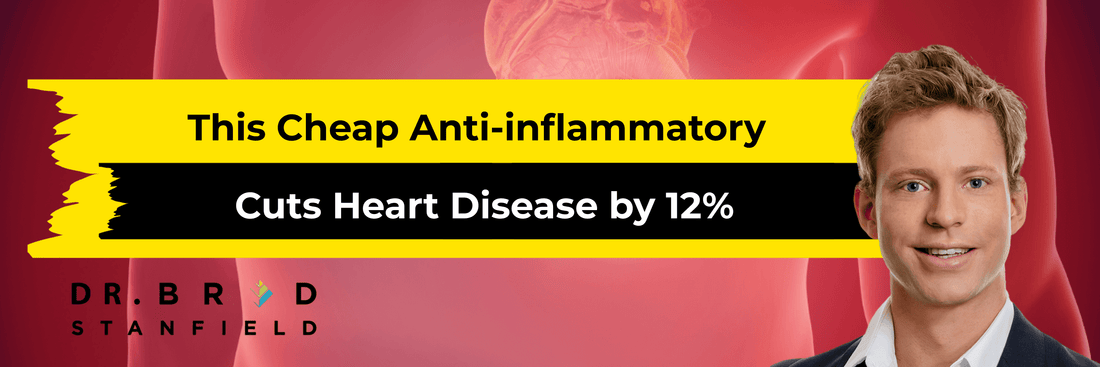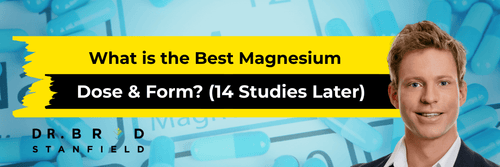A new study published in the European Heart Journal found a cheap anti-inflammatory drug cuts heart disease risk by 12%. And this highlights something many people don’t realize: inflammation is a huge driver of heart disease. It’s like a smoldering fire in our blood vessel walls, weakening them and accelerating plaque formation. But there are many simple things we can do to bring that fire under control, even without medication.
Table of Contents
The New Study
I’m going to walk you through the top ways to combat inflammation naturally. But first, let’s take a look at this study. It identifies a treatment that can be a smart option for those at elevated risk. And it contains an important lesson for all of us.

The study focuses on a specific population: those diagnosed with heart disease caused by the build-up of plaque in their arteries. This build-up is called atherosclerosis. When someone has atherosclerosis, they are at significant risk for things like heart attacks and strokes. Globally, these are the first and fifth leading causes of death [1].
So it’s an urgent priority to identify ways to reduce risks for those diagnosed with atherosclerosis. One option that’s recently caught the attention of researchers is a cheap anti-inflammatory called colchicine.
This medication has an interesting history. It’s found naturally in the plant autumn crocus, which was used by the ancient Egyptians as a remedy for joint pain [2].
Colchicine is mainly used to treat gout, which causes painful joint swelling. But researchers noticed something unexpected. People taking colchicine for their gout were also getting other health benefits.
And some of these benefits are related to heart health. For instance, in a study published in 2012, researchers combed through patient records within a healthcare system in New York. They were looking for those who had filled a prescription for colchicine to treat gout. It turned out they had less than half as many heart attacks as those not taking the medication [3].
This was an intriguing result. And it gave researchers a question to explore: could colchicine be used as a treatment to drive down the risks of heart attacks and strokes?
To answer this question, scientists began to test colchicine in randomized, controlled trials. And things were looking promising. A meta-analysis published in 2024 pulled together findings from 6 trials involving about 15,000 people. The results were dramatic. Those who took colchicine lowered their stroke risk by 27%. And the risk for major heart-related problems dropped by the same amount [4].
But since that analysis, the results are in from two fresh trials — the biggest ones done to date. Their findings cast some doubt.
One found no benefit with colchicine after 3 years in 7,000 patients who’d had a heart attack [5]. The other tested over 8,000 patients who had a stroke. After a 3-month follow up, treatment made no difference to how often patients had additional strokes [6].
So the authors behind the brand-new study wanted to dive back into all the evidence we have to date to figure out what’s going on.
Their analysis included a total of 9 trials involving almost 31,000 people who had heart disease or a stroke [7].
The overall results weren’t as impressive as the earlier meta-analysis, but they were still strongly in favor of the effectiveness of colchicine. Those taking the medication saw a 12% reduced risk of heart attacks, strokes, or death from heart disease [7].
That’s why current clinical guidelines recommend adding colchicine to the treatment mix for those with heart disease [8].
Inflammation and Heart Disease
This is great news for those already diagnosed with heart disease. But the implications of this research are hugely significant for all of us.

High levels of inflammation in our blood vessels is like pouring gasoline on a fire. It accelerates the process of plaque building up in our arteries.
The walls of your arteries start out smooth when you’re young. But sometimes the inner lining of an artery gets damaged — from high blood pressure, smoking, or other factors. A healing process kicks in, but things don’t always return to normal.
Fats and other substances in the blood can stick to the damaged spots. Over time, material builds up into thick deposits of plaque. As plaques grow, they narrow the artery, restricting blood flow — just like how water pipes can get narrower over time.
The greatest danger is when plaques break open. This can cause a blood clot, which can block an artery. If this occurs in an artery feeding your heart, it causes a heart attack. If it happens in an artery going to your brain, it causes a stroke.
One of the most important drivers of this process is LDL particles.
These particles carry cholesterol, and they can move in and out of our blood vessel walls. But if the concentration is too high, LDL gets trapped, leading to plaque development and blockages.
From the PESA study, even when a person’s blood pressure, weight, insulin sensitivity, and inflammation are perfect, plaque still develops if LDL cholesterol is above 50–60 mg/dL — and gets more severe as levels rise [9].

A recent study on "lean-mass hyper responders" — people who are very fit but have sky-high LDL — showed extremely rapid plaque progression [10].

So LDL cholesterol is crucial. But inflammation plays an equally important role. Chronically high inflammation can make LDL cholesterol and other components more likely to stick to artery walls. That, in turn, drives more inflammation — creating a vicious cycle that accelerates plaque formation.
The evidence suggests getting inflammation under control is a powerful strategy to reduce our risks for heart attacks and strokes. While colchicine might be a good option for some people, there are also several proven ways to lower inflammation naturally.
Natural Ways to Lower Inflammation
1. Lose excess weight
Excess fat stimulates the production of chemicals that promote inflammation [11].
2. Eat an anti-inflammatory diet
Getting diet right is more than just reducing calorie intake. Some foods increase inflammation — such as refined starches, sugar, saturated and trans fats [12].

One study of nurses found those who ate a “Western” diet — red and processed meats, sweets, fries, refined grains — had higher signs of inflammation [13].
Other foods help reduce inflammation: fresh fruits and vegetables, whole grains, unsaturated fats (like extra-virgin olive oil), and proteins from legumes and fish.
3. Exercise wisely
In the short-term, exercise is pro-inflammatory due to the micro-damage it causes. But over time, with rest and proper intensity, it reduces chronic inflammation [14].
4. Prioritize sleep
Getting too little sleep increases systemic inflammation and impairs your body’s ability to fight it off [15].

5. Manage stress
Stress is linked to 75–90% of human diseases, largely due to how it triggers inflammation [16]. Tools like mindfulness, meditation, and breathing exercises are simple but effective.
6. Avoid smoking and excessive alcohol
Both are major contributors to inflammation and cardiovascular risk.
Reference List
1. https://www.ncbi.nlm.nih.gov/books/NBK507799/
2. https://pmc.ncbi.nlm.nih.gov/articles/PMC5812812/
3. https://www.jrheum.org/content/39/7/1458
4. https://www.thelancet.com/journals/eclinm/article/PIIS2589-5370(24)00414-0/fulltext
5. https://www.nejm.org/doi/full/10.1056/NEJMoa2405922
6. https://www.bmj.com/content/385/bmj-2023-079061
7. https://academic.oup.com/eurheartj/advance-article-abstract/doi/10.1093/eurheartj/ehaf210/8123896
9. https://www.sciencedirect.com/science/article/pii/S0735109721051159
10. https://www.jacc.org/doi/10.1016/j.jacadv.2025.101686
11. https://pmc.ncbi.nlm.nih.gov/articles/PMC8967417/
12. https://pmc.ncbi.nlm.nih.gov/articles/PMC2868080/
13. https://www.sciencedirect.com/science/article/pii/S0002916522036425
14. https://www.frontiersin.org/journals/physiology/articles/10.3389/fphys.2019.01550/full
15. https://link.springer.com/article/10.1007/s11818-025-00495-6























































